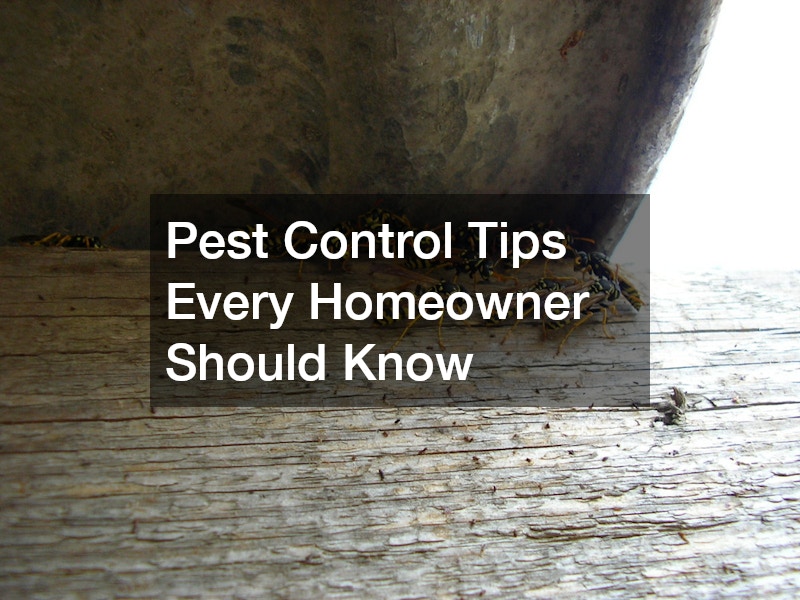Dealing with unwanted pests is a common issue for homeowners across Australia. Whether it’s ants in the kitchen, termites in the walls or rodents in the garage, household pests can cause significant damage and compromise the comfort and safety of your home. While some infestations are easily addressed with store-bought solutions, others require professional help. Understanding the basics of pest control and prevention can save you time, money and stress in the long run.
Understand the Common Household Pests
Different regions across Australia face different pest threats depending on climate, environment and housing design. However, some of the most common household pests include:
-
Cockroaches – attracted to food scraps, moisture and warmth
-
Termites – known for silently destroying timber structures
-
Ants – particularly active in warmer months, often invading pantries and kitchens
-
Rodents – such as rats and mice, which can chew through insulation and wiring
-
Spiders – some of which may pose health risks, like the redback spider
-
Possums – protected native animals that sometimes enter roof spaces
Identifying the type of pest early is essential for selecting the right treatment and minimising damage. In many cases, visual signs such as droppings, gnaw marks or unusual smells can help you determine the type of infestation you’re dealing with.
Prioritise Prevention Over Cure
One of the best pest control strategies is prevention. Keeping your home clean and well-maintained greatly reduces the likelihood of an infestation. Here are a few key preventative tips:
-
Seal entry points – Use weather stripping, caulk and screens to block gaps around doors, windows and vents.
-
Store food properly – Keep food in sealed containers and clean up crumbs or spills immediately.
-
Reduce moisture – Fix leaking taps and ensure good ventilation in bathrooms, kitchens and laundries to avoid dampness.
-
Clear outdoor clutter – Piles of wood, compost and rubbish can be breeding grounds for pests like termites and rodents.
-
Trim vegetation – Keep trees and shrubs away from the house to limit pathways for pests.
Regular maintenance around your home not only protects your property from pests but also contributes to a healthier and more pleasant living environment.
Know When to Call the Experts
While DIY sprays and traps can be effective for small issues, larger or recurring infestations often require professional pest control. Licensed pest control technicians have access to stronger treatments and specialised knowledge to tackle more complex problems.
For example, termite management is particularly important in Australia, where these pests are responsible for significant structural damage each year. Professional termite inspections, typically conducted annually, can help detect colonies early before damage becomes extensive and costly to repair.
Rodents, too, can be persistent and dangerous, as they can carry diseases and chew through electrical wiring. Pest control specialists can identify entry points and nesting sites and implement targeted eradication plans.
Always choose a licensed and insured provider, and don’t hesitate to ask about the products they use—especially if you have pets, children or specific environmental concerns.
Seasonal Considerations
Different pests tend to be more active in certain seasons. Summer, with its warm and humid conditions, often sees an increase in ants, cockroaches and flies. In contrast, rodents tend to enter homes during winter, seeking warmth and shelter.
Plan ahead by conducting inspections and applying preventative treatments at the beginning of each season. For instance, applying surface sprays before summer can help deter crawling insects, while sealing gaps and cracks in autumn can reduce rodent entry in winter.
Being proactive about seasonal pest behaviour helps reduce your chances of an unexpected infestation.
Eco-Friendly Pest Control Options
For homeowners looking to minimise chemical use, there are a growing number of eco-friendly pest control options available. These include:
-
Natural repellents such as vinegar, citrus, peppermint oil and diatomaceous earth
-
Traps that use physical barriers or bait rather than toxins
-
Biological controls, which introduce natural predators to control specific pests (common in gardens)
While these methods are generally safer for the environment, they may not be as fast-acting or long-lasting as chemical treatments. For best results, use them as part of an integrated pest management approach, combining prevention, monitoring and treatment.
Stay Informed and Consistent
Successful pest control relies on consistency. A one-off treatment may provide temporary relief, but long-term protection requires ongoing effort. Keep a maintenance checklist that includes:
-
Regular cleaning and rubbish removal
-
Inspection of damp areas and plumbing
-
Monitoring for signs of pest activity
-
Scheduling professional inspections where necessary
Pests are more than just an inconvenience—they can threaten your property, health and peace of mind. With the right knowledge and preventative measures, you can greatly reduce the risk of infestations and maintain a safer, more comfortable home. Whether you’re handling a minor issue yourself or hiring professionals for more serious problems, effective pest control is an essential part of homeownership in Australia.
.
Dealing with unwanted pests is a common issue for homeowners across Australia. Whether it’s ants in the kitchen, termites in the walls or rodents in the garage, household pests can cause significant damage and compromise the comfort and safety of your home. While some infestations are easily addressed with store-bought solutions, others require professional help. Understanding the basics of pest control and prevention can save you time, money and stress in the long run.
Understand the Common Household Pests
Different regions across Australia face different pest threats depending on climate, environment and housing design. However, some of the most common household pests include:
-
Cockroaches – attracted to food scraps, moisture and warmth
-
Termites – known for silently destroying timber structures
-
Ants – particularly active in warmer months, often invading pantries and kitchens
-
Rodents – such as rats and mice, which can chew through insulation and wiring
-
Spiders – some of which may pose health risks, like the redback spider
-
Possums – protected native animals that sometimes enter roof spaces
Identifying the type of pest early is essential for selecting the right treatment and minimising damage. In many cases, visual signs such as droppings, gnaw marks or unusual smells can help you determine the type of infestation you’re dealing with.
Prioritise Prevention Over Cure
One of the best pest control strategies is prevention. Keeping your home clean and well-maintained greatly reduces the likelihood of an infestation. Here are a few key preventative tips:
-
Seal entry points – Use weather stripping, caulk and screens to block gaps around doors, windows and vents.
-
Store food properly – Keep food in sealed containers and clean up crumbs or spills immediately.
-
Reduce moisture – Fix leaking taps and ensure good ventilation in bathrooms, kitchens and laundries to avoid dampness.
-
Clear outdoor clutter – Piles of wood, compost and rubbish can be breeding grounds for pests like termites and rodents.
-
Trim vegetation – Keep trees and shrubs away from the house to limit pathways for pests.
Regular maintenance around your home not only protects your property from pests but also contributes to a healthier and more pleasant living environment.
Know When to Call the Experts
While DIY sprays and traps can be effective for small issues, larger or recurring infestations often require professional pest control. Licensed pest control technicians have access to stronger treatments and specialised knowledge to tackle more complex problems.
For example, termite management is particularly important in Australia, where these pests are responsible for significant structural damage each year. Professional termite inspections, typically conducted annually, can help detect colonies early before damage becomes extensive and costly to repair.
Rodents, too, can be persistent and dangerous, as they can carry diseases and chew through electrical wiring. Pest control specialists can identify entry points and nesting sites and implement targeted eradication plans.
Always choose a licensed and insured provider, and don’t hesitate to ask about the products they use—especially if you have pets, children or specific environmental concerns.
Seasonal Considerations
Different pests tend to be more active in certain seasons. Summer, with its warm and humid conditions, often sees an increase in ants, cockroaches and flies. In contrast, rodents tend to enter homes during winter, seeking warmth and shelter.
Plan ahead by conducting inspections and applying preventative treatments at the beginning of each season. For instance, applying surface sprays before summer can help deter crawling insects, while sealing gaps and cracks in autumn can reduce rodent entry in winter.
Being proactive about seasonal pest behaviour helps reduce your chances of an unexpected infestation.
Eco-Friendly Pest Control Options
For homeowners looking to minimise chemical use, there are a growing number of eco-friendly pest control options available. These include:
-
Natural repellents such as vinegar, citrus, peppermint oil and diatomaceous earth
-
Traps that use physical barriers or bait rather than toxins
-
Biological controls, which introduce natural predators to control specific pests (common in gardens)
While these methods are generally safer for the environment, they may not be as fast-acting or long-lasting as chemical treatments. For best results, use them as part of an integrated pest management approach, combining prevention, monitoring and treatment.
Stay Informed and Consistent
Successful pest control relies on consistency. A one-off treatment may provide temporary relief, but long-term protection requires ongoing effort. Keep a maintenance checklist that includes:
-
Regular cleaning and rubbish removal
-
Inspection of damp areas and plumbing
-
Monitoring for signs of pest activity
-
Scheduling professional inspections where necessary
Pests are more than just an inconvenience—they can threaten your property, health and peace of mind. With the right knowledge and preventative measures, you can greatly reduce the risk of infestations and maintain a safer, more comfortable home. Whether you’re handling a minor issue yourself or hiring professionals for more serious problems, effective pest control is an essential part of homeownership in Australia.
.



